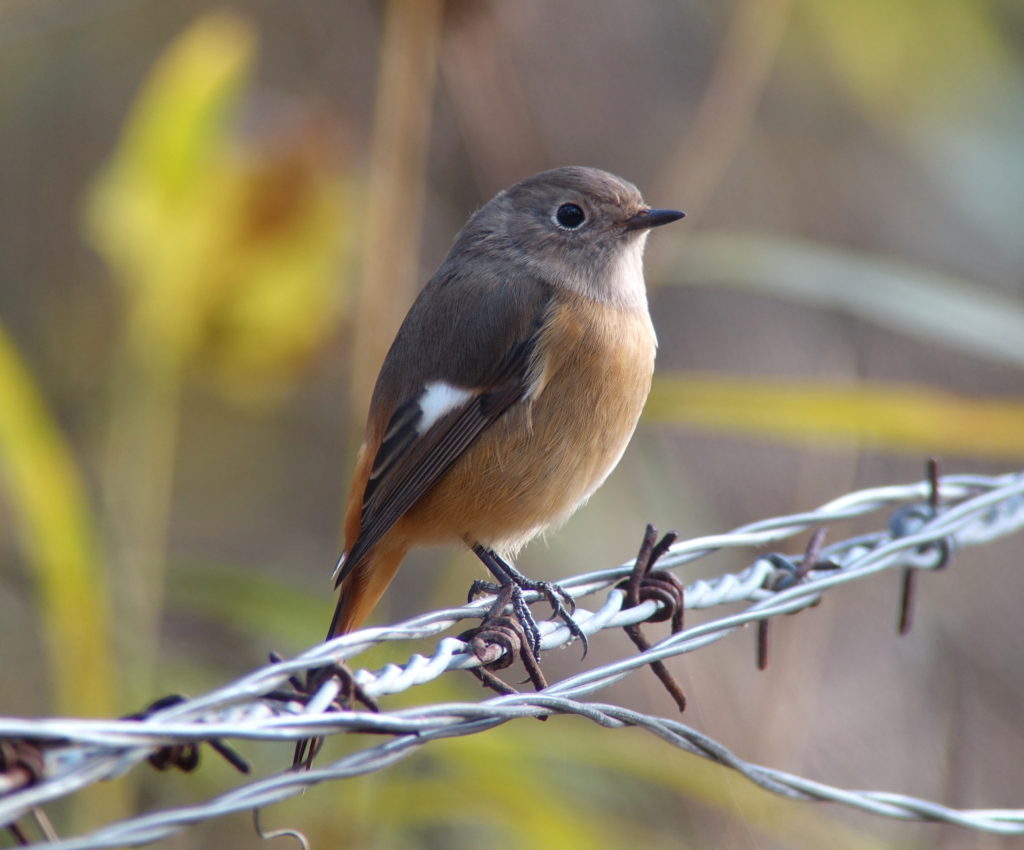Bird News from Nial Moores
On the 13th, in heavy overcast with dense fog through the morning, 76 species were logged in eastern and central Baekryeong. The day started (and ended) back at the small reed-bed in Jincheon where I managed some recordings of the vocalizing (presumed) Western Water Rail. The bird called infrequently (generally for one minute every hour or so), giving squeaky calls identical to recording XC297872 on Xeno Canto (made in the Netherlands). Playing this recording in response through my phone (happily an older, non-exploding Samsung model), the bird responded, and came to within less than a meter of me, showing a streaky back and flashing for less than a second what appeared to be clean butterscotch undertail coverts as it scuttled back into even deeper cover. In addition, several other short, harsh, deeper notes were heard in a different part of this small reedbed that suggested Eastern Water Rail – once given simultaneously with the presumed Western and several other species alarm-calling at a nearby Northern Goshawk. One Little Owl also reappeared there in the evening.
During the middle of the day, walking through the rice-fields towards Hwadong wetland species of note included a late Western Osprey, a Chinese Grey Shrike (impaling a long-tailed lizard) and a single Upland Buzzard.
 Western Osprey Pandion haliaetus © Nial Moores (and an alternative explanation for the species’ name?)
Western Osprey Pandion haliaetus © Nial Moores (and an alternative explanation for the species’ name?)
On or near to the lake I counted c. 1400 geese (comprised of 1300 Tundra and 70-80+ Taiga Bean Geese and a dozen or so Greater White-fronted, including what appeared to be a single adult albifrons-type in with a dozen or so “albicans”) and 39 Baikal Teal.
 Mixed goose flock, with albifrons-type Greater White-fronted Goose at centre-right and more typical looking “albicans” front-left © Nial Moores
Mixed goose flock, with albifrons-type Greater White-fronted Goose at centre-right and more typical looking “albicans” front-left © Nial Moores
However, the Hwadong wetland was extremely poor. It is now disturbed massively by the new road – and near-empties of birds at the approach of anyone on foot. Best there was a single Northern Lapwing.
 Northern Lapwing Vanellus vanellus © Nial Moores
Northern Lapwing Vanellus vanellus © Nial Moores
On the 14th, skies cleared and the wind swung around to the north. A total of 61 species were recorded in Jincheon, including the (presumed) Western Water Rail heard again; 13 Daurian Jackdaw in with a flock of 40 Rook; 12+ Yellow-bellied Tit; two Chinese Penduline Tit in the “water rail reedbed”; four Red-billed Starling; 2-5 Eyebrowed Thrush; 15+ Daurian Redstart (including one extremely bright female); five Siberian Accentor (happily not all of them decided to go to Europe this autumn…) and two Chinese Grosbeak.
 Chinese Penduline Tit Remiz consobrinus © Nial Moores
Chinese Penduline Tit Remiz consobrinus © Nial Moores
 Daurian Redstart Phoenicurus auroreus © Nial Moores
Daurian Redstart Phoenicurus auroreus © Nial Moores
Most educational (or perhaps confusing) was a group of 8+ feeding Pallas’s Reed Bunting which showed as much within-group variation as I have ever seen, including major differences in size, bill profile and plumage tones (leading once more to the question as to how to identify the enigmatic lydiae or “Mongolian Reed Bunting”). This flock was joined loosely by four Ochre-rumped and three Common Reed Buntings.




 Pallas’s Reed Bunting Emberiza pallasi Four different individuals (bottom two images of one bird), showing a little of the variation © Nial Moores
Pallas’s Reed Bunting Emberiza pallasi Four different individuals (bottom two images of one bird), showing a little of the variation © Nial Moores
There were also 12 American Scoter off the east coast, including one leucistic adult male, with extensive splashes of white on both flanks.
 American Scoter Melanitta americana, with piebald male second from the right © Nial Moores
American Scoter Melanitta americana, with piebald male second from the right © Nial Moores
On the 15th, in much more seasonal weather with northerly winds and a maximum of 6C, 62 species were logged in Jincheon, Junghwadong, Dumujin and part of Yeonhwa Ri. Species of most note were single Upland and Rough-legged Buzzards (my personal first on this island) and half-a-dozen Siberian Accentor and Long-tailed Rosefinch. The Little Owl also showed well in the evening in Jincheon – though there was no sign of the (presumed) Western Water Rail.
 Siberian Accentor Prunella montanella © Nial Moores
Siberian Accentor Prunella montanella © Nial Moores
On the 16th, a final morning in Jincheon was followed by a quick Munhwa-assisted drive around the main reservoir in an unsuccessful search for Oriental Storks. Sixty species were logged and while numbers of more numerous species like Brambling, Rustic and Yellow-throated Buntings had all fallen below 25 each, highlights included a 1st calendar year Greater Spotted Eagle; another Upland Buzzard; the same Chinese Grey Shrike as seen on the 13th; 60+ Dusky and Naumann’s Thrushes; at least seven Siberian Accentor; 4+ Long-tailed Rosefinch; a Pine Bunting; and a probable Red-breasted Flycatcher heard.
 Greater Spotted Eagle Clanga clanga © Nial Moores
Greater Spotted Eagle Clanga clanga © Nial Moores
 Pine Bunting Emberiza leucocephalos © Nial Moores
Pine Bunting Emberiza leucocephalos © Nial Moores
 Yellow-throated Bunting Emberiza elegans © Nial Moores (beautiful, but elegant?)
Yellow-throated Bunting Emberiza elegans © Nial Moores (beautiful, but elegant?)
All images taken with a handheld Sony RXIII through a truly superb Swarovski scope…

